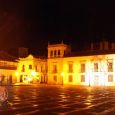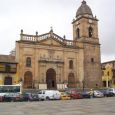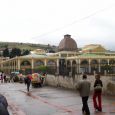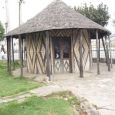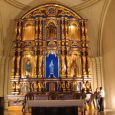Tunja
Advertisement
By air
Gustavo Rojas Pinilla airport. It is currently used by small aircraft and sporadic routes without permanence for commercial flights. Normally used as domestic and international air out the El Dorado International Airport of Bogotá.
By railway
The railway is used for freight transport is managed by FENOCO within the concession of railway lines in northern Colombia.
By road
In Tunja, the public transport network, is comprised of: Public Transport passenger urban taxi system, system of bike paths and wagon roads. The main land routes of access are the Core BTS (Briceno-Tunja-Sogamoso) and the A62 leading to the city of Bucaramanga, both belonging to the Pan-American Highway. In the urban area is the North Central Trunk which connects the urban area with the cities of Duitama and Sogamoso, Eastern Avenue with access to the bus terminal, the races 10 and 12 atraviezan the historic center, and T19 Avenue -Columbus Avenue (access to the cities of western department as Chiquinquirá ) converge at the Monument to Columbus. In the northeastern district is University Avenue. In the eastern Juan Nepomuceno Nino Viaduct connects the historic center with the north. It is expected the end of the Viaduct Walk of Interior, which communicates with the BTS core urban area in less time.
Advertisement
Santiago Metropolitan Cathedral Basilica of Tunja
Tunja Cathedral, officially Santiago Metropolitan Cathedral Basilica of Tunja, is the cathedral church of worship Roman Catholic oldest Colombia, which is dedicated under the patronage of the Apostle James the Greater. The building is located on the eastern side of the Plaza de Bolivar in the historic center of town Colombia of Tunja. The cathedral is the principal church of the Archdiocese of Tunja and seat archbishop, from his elevation to diocese by the Bull of Leo XIII called Infinitus love and published on July 29th of 1880.
Well Hunzahua
The Hunzahua Well, formerly known as Pozo de Donato is an archaeological park and museum culture Muisca which is located north of the city of Tunja - Colombia, in the ancient sacred site of the City of Hunza.
Church of the Snows
The Church of the Snows is a temple located in the historic center of the city of Tunja in Colombia, built in 1572 and remodeled in the mid twentieth century.Founded in honor of St. Peter the Apostle in 1572, under the leadership of Mayor Miguel Holguin, later adopted the title to the Virgen de las Nieves. Preserved altarpieces, ornamentation and artwork of the original temple belonging to the Augustinian community.
Plaza Real from Tunja
The Plaza Real de Tunja is a building of neoclassical architecture Republican Tunja, Colombia's national heritage site by Decree 3070 of December 20, 1990, where he worked the old Market Square in the city.Masterpiece of Republican architecture in the nineteenth and twentieth centuries, its characteristic pyramidal style neoclassical dome in addition to the style of Monte Carlo Casino are its main attributes. It was built on celebrating the centenary of the Battle of Boyaca in 1919 by President Marco Fidel Suarez. Subsequently 6 pavilions were built around him, and was reinagurada by President Eduardo Santos on August 6, 1939, to commemorate 400 years of Hispanic foundation of the city.
Church of St. Ignatius
The Church of San Ignacio is a temple located in the historic center of the city of Tunja in Colombia, launched in 1620 by the Society of Jesus, established in the city since 1610.The imagery of the church came in 1640, included the Martyrs of Japan, San Francisco Javier, San Carlos Borromeo, sculptures have disappeared. The original design of the work is inspired by the traditional model jesuísticos temples consisting of a wide nave and a chancel. The tent is designed for tunjanos 1650. The church tower was accidentally modified in 1905, being masked in the modern architectural complex.
Church of Santa Barbara
The Church of Santa Barbara is a work completed by the City Council of Tunja in 1599. It has a single nave with side chapels by way of cruising. His altarpiece main three bodies and three blocks were made with imagery polychrome. It also has a polychrome wood carving of "Santa Barbara" style Neoclassical, gold-gilded impressive realism. Other notable pieces are the main oil dating from 1657, a design with 12 angels in oil of the seventeenth century, the chapel of the Virgen del Pilar decorated with images of American fauna and important works of eighteenth-century silver.
Palacio de la Torre
The Captain's House Cifuentes Gomez better known as the Palacio de la Torre is a Spanish colonial mansion neoclassical center Tunja National Heritage. He is currently the headquarters of the Interior Department BoyacaIt is a major architectural works of the city. It was built by Gomez de Cifuentes with the particularity of its Moorish style tower Monastery of El Parral, in honor of his wife Isabel Contreras, originally from Segovia. Remained intact until 1939, which was remodeled in neoclassical French Republican air, although it retained some Tuscan columns. As a museum, preserved the paintings of the 13 presidents and 88 governors Boyaca department.
Hermitage of San Laureano
The 'Chapel of San Laureano' is the first church built in Tunja by order of council in 1566, at that time was on the outskirts of the city, en route to Santa Fe (Bogota). By 1816 it was the place where they buried the characters of Independence who were shot in the wall of the Martyrs. To emphasize, is an oil painting of the Virgin of Chiquinquira dating from the late seventeenth century, the altar ojillado in gold and a canvas painting of St. Francis Xavier in 1628 by Alonso Fernandez de Heredia, the workshop santafereno Gaspar de Figueroa. The oil of St. Bartholomew, gloomy style dates from 1623.
Convent of Santa Clara la Real
The Convent of Santa Clara la Real is the first monastery established in the New Kingdom of Granada in 1571. It is composed by 8 galleries with octagonal supports and arches, together with stone columns Doric - Tuscan. It was the place where the writer Del Castillo wrote the 753 pages of his masterpiece, and is also patron of the arts and abbess.
Church of San Francisco (Tunja)
The Church of San Francisco is a finished work by 1640 in the historic center of the city of Tunja, is one of the 14 major colonial churches of the city.
Church of Our Lady of the Miracle of Top
The Church of Our Lady of the Miracle of Topo is one of the 14 major Hispanic churches of Tunja. Its construction dates from 1599, but changed his invocation to the Virgin of the Miracle in 1880.
Cloister of the Society of Jesus
The Senate of the Society of Jesus was one of 14 Hispanic churches in Tunja. In 1819, became the headquarters of the College of Boyaca, founded by Francisco de Paula Santander.
Zaque cushions
The cushions Zaque Indian is a monument located in Tunja, Colombia, designed by the people Muisca as a center of sun worship, sun king and where they held a ceremony procession in ancient times. Consists of two large monoliths fastened to cushion the side of the hill of St. Lazarus in the west of the city. He was one of the main sites of the chieftainship of Hunza. Preserved as part of the historical heritage of the City.
January - March
Information not available
Advertisement

